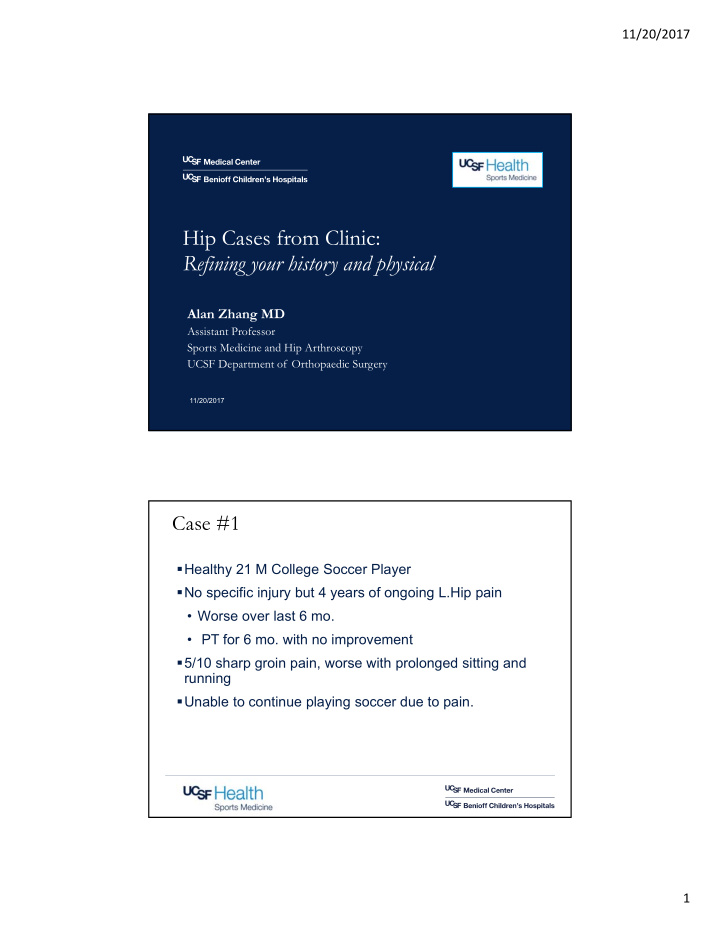



11/20/2017 Hip Cases from Clinic: Refining your history and physical Alan Zhang MD Assistant Professor Sports Medicine and Hip Arthroscopy UCSF Department of Orthopaedic Surgery 11/20/2017 Case #1 Healthy 21 M College Soccer Player No specific injury but 4 years of ongoing L.Hip pain • Worse over last 6 mo. • PT for 6 mo. with no improvement 5/10 sharp groin pain, worse with prolonged sitting and running Unable to continue playing soccer due to pain. 1
11/20/2017 History PMH: None Social: Full time Student PSH: Wisdom Tooth No Tobacco extraction FHx: None Allergies: NKDA Meds: None Physical Exam: Left Hip Normal Gait Non-tender to palpation Flexion: 115 (120) Extension: 10 (10) IR: 20 (30) ER: 50 (50) 5/5 strength throughout + FADIR -Ober’s, Log roll. 2
11/20/2017 Imaging 3
11/20/2017 FAI: Basics Clinical Question What is the best surgical treatment for Cam predominant FAI in Athlete who fails non-operative management? 4
11/20/2017 Diagnosis and Treatment Options Diagnosis: Treatment Options: Femoracetabular Non-Op Impingement: Cam Physical Therapy lesion subtype Activity Modification Rest Surgery Outcomes in Athletes Byrd et al 2011 • 200 athletes with 2 year follow up after hip arthroscopy • 90% returned to sport (95% pro, 85% collegiate) Nho et al. 2011- AJSM • 35 Athletes Varsity High School to Professional • Significant improvement in PRO • 79% return to play within 1 year 10 5
11/20/2017 Patient Studies demonstrate: Arthroscopic femoroplasty with labral repair in athletes result in significant improvement in symptoms and return to play. Taken to OR for Arthroscopic femoroplasty and labrum repair Labral Tear and Cartilage Injury 6
11/20/2017 Labral Repair Femoroplasty Images 7
11/20/2017 Removal of Cam lesion Case 2 CC: left hip pain HPI: 64F geologist p/w 1 year left hip pain located on lateral aspect of hip. 4/10. No traumatic event. Insidious onset. • Initially improved and then worsened over the course of the year. • In 1/2015, she noticed pronounced weakness, which was new. • No improvement with PT. • Intra-articular corticosteroid injxn in 10/2015, which helped. • However, persistent weakness preventing her from working exercising at gym. PMHx/PSHx: no previous hip injury or surgery Meds: None 8
11/20/2017 Trendelenberg Gait 9
11/20/2017 Imaging Imaging 10
11/20/2017 Gluteus Medius Tears Atraumatic, insidious onset of lateral-sided hip pain • Degenerative tear commonly in setting of chronic trochanteric bursitis • Most common Acute traumatic injury Iatrogenic • Avulsion after total hip replacement 11
11/20/2017 Anatomy Treatment Options? 12
11/20/2017 Operative Techniques Approach • Open vs. Endoscopic Repair • End-to-End • Suture anchors ‒ Partial-thickness Transtendinous Repair ‒ Full thickness Completion of tear and suture bridge repair Back to Our Case 1) Left hip endoscopic gluteus medius repair 2) Iliotibial band release (lengthening) 3) Bursectomy of trochanteric bursa 13
11/20/2017 Gluteus Medius Tear 14
11/20/2017 Repaired Gluteus medius 29 Case #3 HPI: • 63yo healthy man, h/o staged bilateral MoM THA (Oct/Dec 2010, OSH) via posterior approach • Persistent L groin pain post-operatively • Constitutional sx’s negative, R hip no symptoms • Attempted NSAIDs, PT PMH: None significant PSH: Bilateral THA (Left Oct 2010; Right Dec 2010) 30 15
11/20/2017 Hip range of motion Flex. Ext. IR ER Abd. Add. left 110 0 20 40 40 20 right 120 0 20 40 40 20 L leg- pain w/ aSLR and any rotation of hip referred to groin. Hip strength Flexion Extension Abduction Adduction Left 4+ 5 5 5 Right 5 5 5 5 Provocative Tests: Flexion/Internal rotation for labral tear: negative Log roll test: negative FABER test: positive Ober’s test negative Straight leg raise: negative Positive Stinchfield- rested straight leg raise Case Presentation 16
11/20/2017 Imaging MRI: • No evidence of pseudotumor/ AMR • Intact gluteus medius/ abductor complex Case Presentation Outside Hospital Workup • Labs: ‒ ESR, CRP- wnl ‒ Serum Co, Cr - wnl • 3 Phase Bone Scan: ‒ Negative. No evidence of uptake c/w osteolysis/loosening, infection • MRI: ‒ Negative. No evidence of pseudotumor, adverse metal reaction (AMR) Given constellation of symptoms, Left groin pain with aSLR, recommended guided CSI 17
11/20/2017 Case Presentation RT, 63yo M with L hip pain Received fluoroscopic-guided corticosteroid injection, which provided complete, temporary relief Background Anterior iliopsoas impingment (IPI) is a rare, poorly understood condition Up to 4.3% of patients with persistent groin pain after THA 1 May be related to changes in hip biomechanics following THA Or related to direct mechanical irritation 1. Lachiewicz and Kauk. JAAOS (2009) 18
11/20/2017 Background Iliopsoas anatomy • Confluence of psoas and iliacus mm., insert to anteromedial lesser trochanter • Anatomic variation: iliacus length, separate/conjoined tendons, overlying bursa Clinical Presentation • Persistent groin pain, activity-related/ transfers • Pain with resisted hip flexion (aSLR), little/no pain with passive leg raise • Often little/no pain with ambulation Lachiewicz and Kauk. JAAOS (2009) Retrospective case series (2012) 10 cases of iliopsoas tendinitis 9 patients underwent guided tendon injection; 8/9 had relief All underwent endoscopic iliopsoas release (at the level of the lesser trochanter) Mean follow up: 20 months (12-60) 8/10 (80%) complete relief, 2/10 partial relief Mean post-op WOMAC score 84 (60-95) from 34 (24-46) Full (5/5) hip flexion strength obtained by 3 months post op (0.5-6) No complications 19
11/20/2017 Our Case… 20
11/20/2017 21
11/20/2017 Thank You Alan Zhang, MD alan.zhang@ucsf.edu 415-353-4843 44 11/20/2017 22
Recommend
More recommend